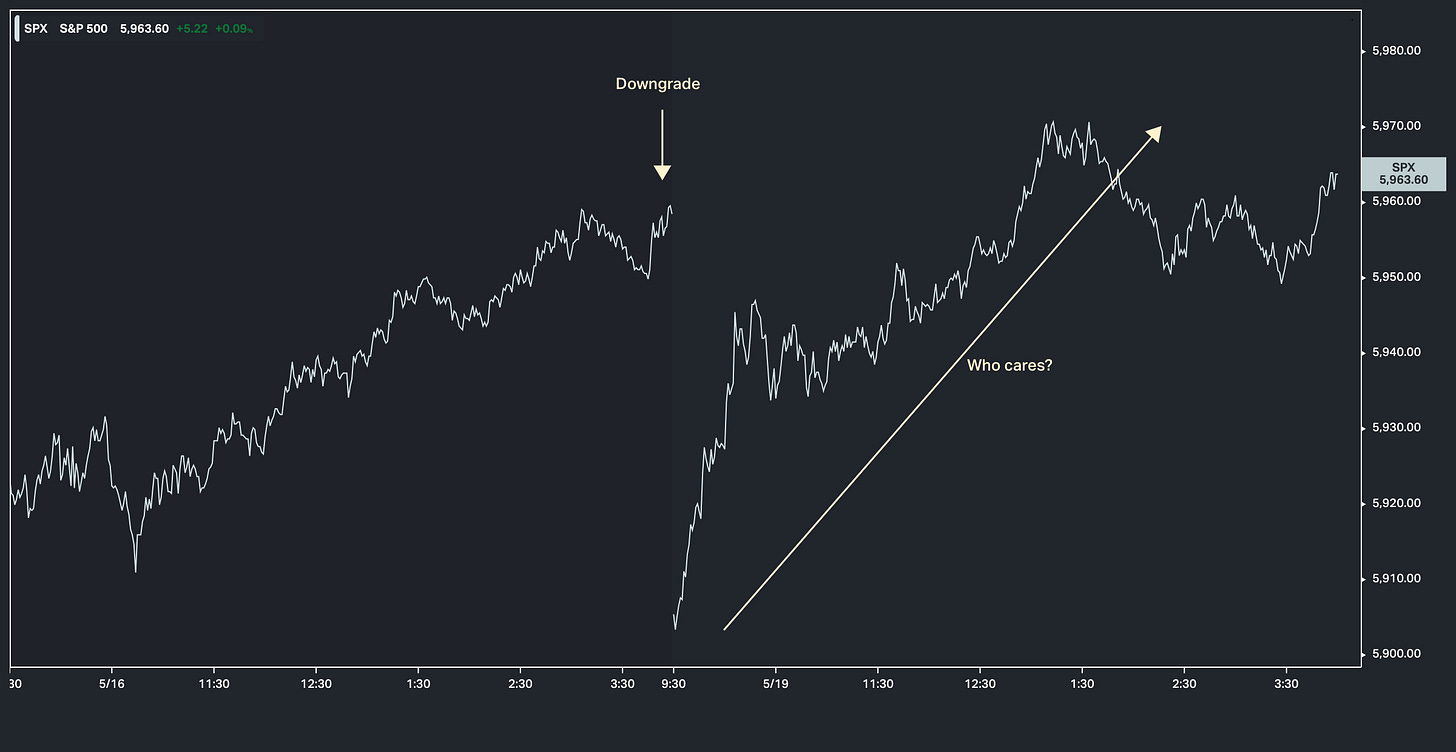See? Nobody Cares.
US equites pared early losses Monday, with the S&P 500 ending 0.1% higher after falling 1.1%, as Treasury yields retreated from highs.
The Dow added 137 points, while the Nasdaq was marginally higher, as markets digested Moody’s downgrade of the US credit rating to Aa1, citing growing deficits and refinancing risks.
Treasury Secretary Scott Bessent downplayed the move and urged trade partners to engage during the 90-day tariff pause.
President Trump continued to push companies like Walmart to absorb tariff costs.
Energy, consumer discretionary, and tech sectors lagged, while healthcare, industrials, and utilities helped limit broader losses.
Over the past two weeks we talked about the signalling by Moody's that a U.S. credit downgrade was coming.
They assigned a "negative outlook" to the rating in 2023. That, by their definition, increased the risk of a rating downgrade "over the next one to two years."
So, we are now two years out, near the end of that time window. And on cue, in late March they telegraphed the downgrade with a warning that U.S. fiscal strength had "deteriorated further".
And as we discussed in my May 9th note ( V-Shape ), that warning came ahead of expected budget and debt ceiling negotiations. If we look back at the S&P U.S. credit downgrade in 2011, and the Fitch downgrade in 2023, both surrounded ... debt ceiling issues.
Now, interestingly, both of these prior downgrades occurred AFTER the debt ceiling was raised.
In 2011, S&P downgraded U.S. credit three days after the debt ceiling was raised.
In 2023, the debt ceiling was "suspended", which raised the debt limit until January 1 of this year (2025), giving the Yellen-led Treasury license to issue unlimited debt for the next two years (through the end of the Biden first term). It was two months later that Fitch downgraded U.S. credit.
As for this Moody's downgrade, not only was the news released Friday after the market closed, but it comes while Congress is negotiating the budget and BEFORE the debt ceiling raise.
So, clearly this will create negotiating leverage and public talking points for the members of Congress that oppose the Trump plan.
This reminds me of the 2021 Fed influence on the Biden agenda.
Back in 2021, three trillion dollars of fiscal stimulus was already approved and working through the economy, to such a degree that the economy was already near a full V-shaped recovery (by late January, the time Biden took office).
The CBO (Congressional Budget Office) was projecting the economy to grow at a 3.7% annualised rate (hotter than pre-pandemic growth), with falling unemployment.
But the new Biden administration had a huge and very expensive climate agenda to fund. It included an immediate $1.9 trillion massive spend (quickly approved). Conveniently, the politicians on Capitol Hill justified it by citing the Fed (its view that inflation wasn't a threat).
Then the Biden administration lined up another $4.5 trillion in deficit spending, again justified by the Fed's "transitory inflation" view, only to be derailed late in the game by a party defector, Manchin.
All of this to say, this downgrade from Moody's looks politically motivated. The question is, other than creating an impediment in budget talks, does it matter?
Moody's is one of the three "Nationally Recognised Statistical Rating Organisations" designated by the SEC. It was Moody's and its two counterparts (S&P and Fitch) that brought us the real estate bubble, which turned into the global financial crisis.
Yes, that real estate bubble was primarily driven by credit agencies stamping AAA ratings on high risk/high yielding mortgage securities. These unwarranted ratings were a mix of fraud, mal-incentives and incompetence (on the part of the ratings agencies).
With a AAA rating and a high yield, massive pension funds had no choice, if not an obligation, to plough money into those investments. And with that insatiable demand, mortgage brokers and bankers were incentivised to keep sourcing them and packaging them. And the bubble was blown.
With that, it's perplexing that they (the ratings agencies) are still in business, much less have credibility.
“To go back to your question about the Moody’s downgrade, who cares?" - Treasury Secretary Scott Bessent, 2025.
PS: Our quantitative strategies achieved their mission - better risk adjusted returns; SPX drawdown -17.1% vs -5.2% for Market Signals vs -5.7% for Daily Mean Reversion. More information in the latest report → Market Signals Report.
If you have performance responsibility and are looking to take on asymmetric risk, you really should become a member of The Gryning Times (global trend report not shown);








